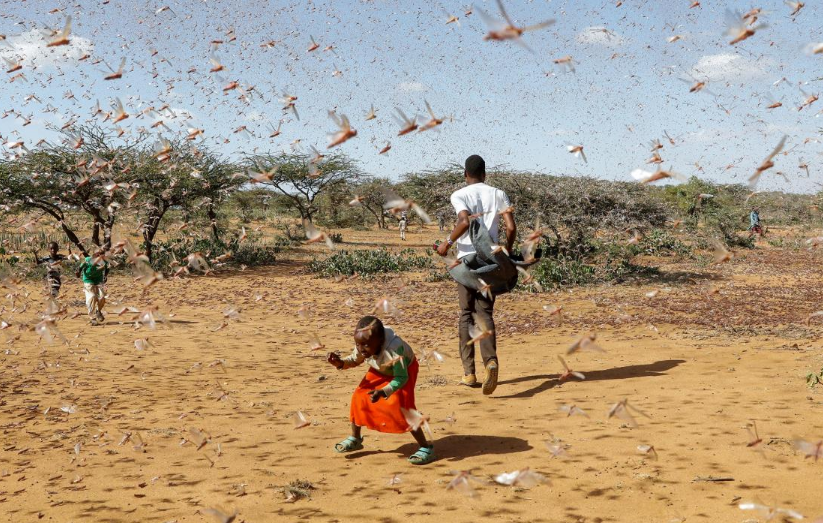They first appear as great black smears on the horizon. As they move closer, they blot out the sun and the land goes dark. Then, to the growing rhythm of millions of beating wings, they drop lower and lower, devouring all in their path.
Patrick Mutugi, a farmer in Meru, eastern Kenya, watched in horror as the worst locust plague to hit the Horn of Africa for more than 70 years invaded his land. Terrified villagers, fearing that the insects would enter their homes, tried to chase them away, to no avail. “They ran around, singing, shouting, even throwing stones to try to frighten them off,” he said. “When the swarm descends, the air is so thick with them you can barely see. They carpet the ground.” Crops are stripped bare. The locusts move on.
“The first swarms we saw were massive — three or four kilometres wide and a thousand metres deep,” said Mark Taylor, a commercial farmer in the Laikipia region of northern Kenya. “They attacked everything. Fifty-four hectares [133 acres, 540,000 square metres] were destroyed just like that. Later, the swarms settled on trees, so many of them that branches broke under the weight. Next morning they took to the wing again, carried along by the equatorial winds towards farmlands and populated areas.”
Such terrifying sights were repeated across large swathes of Ethiopia and Somalia last year. Locusts, brown and yellow insects, each the size of a small adult finger, devastated crops and precious pasture lands, leaving ruined livelihoods in their wake.
Now, with insecticide spraying happening again in the region, fears are growing about the longer-term destruction inflicted by the United Nations’ efforts to resolve the crisis. One MP told The Sunday Times that Kenya’s government had failed its population by allowing the mass use of chemicals banned in the West.
The locusts began to sweep over the land in late 2019, from breeding grounds in the deserts of Yemen and the Arabian peninsula, nurtured by downpours from Middle Eastern cyclones in 2018.
Their arrival demanded a military-style response but the Kenyan government was ill-prepared and the responsible UN body, the Food and Agriculture Organisation (FAO), appeared caught off guard by the size of the challenge.
The FAO quickly scrambled resources and led an aerial and ground assault, dousing an area of 4.5 million acres (18.2 billion square metres) with almost half a million gallons of chemical insecticides, some of which are banned in many parts of Europe and North America, ignoring its own guidelines to use such insecticides sparingly and only as “a last resort”.
Initially hailed as a success because it protected food supplies for as many as 32 million vulnerable people in the greater Horn of Africa and averted the type of Ethiopian-style famine witnessed in the 1980s, the FAO’s response, which mobilised dozens of bush pilots and youth volunteers, is now raising concerns about damage to the environment.
Northern Kenya, in particular, is known for its rich bee and insect diversity. Critics say that widespread use of such chemical insecticides, which remain toxic for months, could cause serious harm to other insects, wildlife and even humans.
In a statement to The Sunday Times, the FAO admitted it was using three organophosphates — chlorpyrifos, fenitrothion and malathion — that are banned in Europe and much of America. One of them, chlorpyrifos, was banned in most of the US at the time it was used in Kenya but has since been banned in all states.
Another insecticide used by the FAO is deltamethrin, a synthetic pyrethroid especially toxic to bees and fish that is banned in Denmark, but not in the rest of Europe or America. The organisation’s own guidelines say the products should be used only as a last resort.
The FAO said it supported “the safe use of pesticides and community outreach campaigns to ensure safe treatment and monitoring”. Its own data, however, categorises all four chemical insecticides as high risk to bees, low or medium risk to birds, and medium or high risk to locusts’ natural enemies and soil insects, such as ants and termites.
In addition, the FAO has not reassessed its list of insecticides for at least six years, a period during which the world has become much more environmentally conscious.
Scientists and conservationists in Kenya said there had been too much emphasis on controlling the locusts and insufficient attention paid to possible environmental damage. They advocate the use of more expensive, but homegrown, organic products that lose their potency within 24 hours of use.
“The effects of these chemicals can be felt for months,” said Ian Shaw, a British-born investor in Kenya, whose company, Kapi, produces a locally grown alternative made from pyrethrum, a white flower with a yellow centre rather like a large daisy. The plant was introduced to Kenya from Japan in the 1920s and was used for years to fight malaria and other insect-borne diseases.
Gladys Boss Shollei, an MP who is fighting to ban the use of dangerous insecticides in Kenya, asked why pyrethrum had not been adopted more widely. “The government through the regulatory organs have failed Kenyans by allowing harmful chemicals banned in Europe to be imported in large quantities into our country,” she said.
Shollei, who has received death threats because of her campaign, has promised to take Kenya’s Pesticides Control Products Board (PCPB) to court over the affair, citing evidence of increased cancer rates in villages near where the chemicals have been used.
“These same chemicals are known to have caused cancer elsewhere yet we use them,” she said. “Despite the board knowing of the dangers, they still allow the pesticides to be sold here in Kenya. All we are asking is to have all pesticides banned elsewhere to be removed from our country.”
Shaw and other supporters of natural organic products particularly want them used in areas inhabited by people and cattle. “Pyrethrum products may be more expensive, but overall it is safer and it does not have to be used everywhere but as part of a holistic approach,” he said. “It, too, will kill some bees but not as many. Why continue to kill bees for six months after the locusts have left rather than affect them for just 24 hours?”
One Kapi product, Flower DS 4EC, was given the all-clear by the PCPB last July after trials showed that it had a 96-100 per cent kill efficacy. But there has been little enthusiasm for it in either the Kenyan government or the FAO, whose regional office in the Kenyan capital, Nairobi, has all its trial data.
“Currently there are very few options available for effective locust control in terms of chemical pesticides, or biological or natural-based pesticides,” the FAO said. “Chlorpyrifos, fenitrothion, malathion and deltamethrin have been used in locust control during the East Africa upsurge.
“Their use is based on the results and recommendations of the pesticide referee group, a panel of independent experts that assesses effectiveness, safety and risk.
“It was imperative to have a robust and effective locust control campaign in 2020-21. The size of these swarms posed a serious threat to food security in a region where millions of rural families were already coping with high levels of acute hunger.”
Even a small swarm, the FAO added, could eat in one day the same as 35,000 people. One swarm spotted in Kenya last year was up to 60km long and 40km wide, covering an area as large as Luxembourg.
For those unlucky enough to find themselves in its path the spectacle of a swarm has been unforgettable. “It is eerie and surreal,” said Patrick Loruapon, a subsistence farmer in northern Kenya, recalling the moments when his entire crop was destroyed within minutes. “As they came down they blanketed the whole area. They were everywhere. I could hear the children in the village screaming.”
Now other communities across the region are facing the same grim fate. In Somalia, an FAO-led operation equipped with the same cocktail of insecticides has already begun spraying again.








































admin in: How the Muslim Brotherhood betrayed Saudi Arabia?
Great article with insight ...
https://www.viagrapascherfr.com/achat-sildenafil-pfizer-tarif/ in: Cross-region cooperation between anti-terrorism agencies needed
Hello there, just became aware of your blog through Google, and found ...